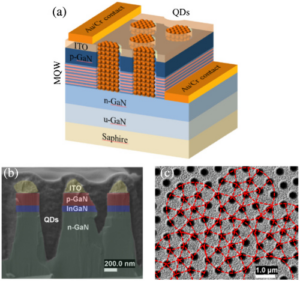(a) Schematic representation, (b) cross-sectional, and (c) top SEM images of a photonic quasi-crystal LED hybridised with QD colour convertersA
An international research group has used quantum dots to create a hybrid LED. QDs are embedded within the whole stack of the LED’s active layers. This photonic quasi-crystal LED structure boasts ‘record-breaking’ colour conversion effective quantum yields.
The first step was to grow an LED stack of GaN/InGaN Multi-Quantum Well (MQW) onto a sapphire substrate. Nano-imprint lithography and plasma etchings were then used to ‘punch’ the stack and structure as a 12-fold symmetric quasi-crystal (PQC). The structure formed an array of 480nm-radius cylindrical holes, with a lattice pitch of 750nm. It was etched deep enough to penetrate through the whole MQW active area and filled with a blend of QDs, deposited through a spin coating process.
QD emitters, in this architecture, are placed near to the MQWs of the active area. The researchers write that this improves the out-coupling efficiency between MQWs and QDs, which enables a non-radiative resonant energy transfer between the two, and near-field radiative coupling of trapped (guided) modes in the LED to the emitters.
Effective quantum yields reached 123% for single QD species colour converters, and around 110% for a white blend of three commercially-available QDs (green (535nm), yellow (585nm) and orange (630nm)). These achieved a ‘quasi-perfect’ 6,500K D65 spectrum. It is thought that performance could be further improved using nanocrystalline emitters.
The work can be found at http://tinyurl.com/zts6765.
The research group was made of staff from two Schools (Electronics & Computer Science and Physics & Astronomy) at the University of Southampton (UK); Luxtaltek Corporation (Taiwan); the Department of Photonics & Institute of Electro-Optical Engineering, National Chiao Tung University (Taiwan); and the Centre for Photonics and Quantum Materials, Skolkovo Institute of Science and Technology (Russia). Funding was supplied by the Royal Society; the Engineering and Physical Sciences Research Council; the UK-India Education and Research Initiative; and the Ministry of Science and Technology of the People’s Republic of China.

